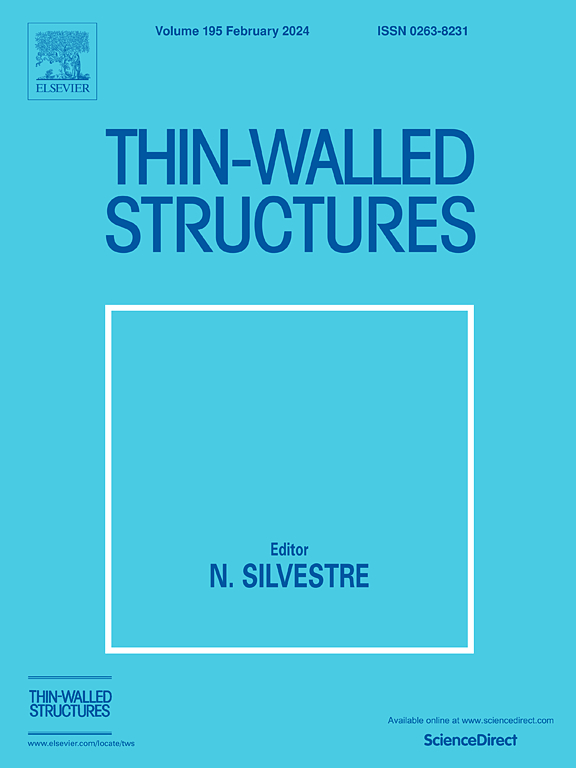Reconfigurable topological gradient metamaterials and potential applications
IF 6.6
1区 工程技术
Q1 ENGINEERING, CIVIL
引用次数: 0
Abstract
Elastic topological metamaterials are innovative fields of the fusion of physics and mechanics. Through novel microstructural designs, elastic topological metamaterials provide a pioneering approach to precisely manipulate elastic waves, maintaining robustness and efficiency in wave propagation even within complex environments. Recent advancements in reconfigurability and gradient features have significantly enriched the mechanical phenomena of wave manipulation, broadening the application potential of elastic topological metamaterials. In this study, we design the local resonant phononic crystal, employing a spiral support structure to ensure low-frequency characteristics and adjustable mass for flexible configuration. By utilizing the designed lattices with distinct topological phases, the topological valley edge states are constructed. The frequency and group velocity variation of the topological edge states under different stiffness and mass parameters are analyzed. Furthermore, we further constructed the mass and stiffness gradient metamaterial to analyze the transmission law of elastic waves in topological metamaterials. Additionally, the fluctuation features of the wave transmittance under disordered and impurity defects were discussed, confirming the robustness of waveguides within low-frequency topological metamaterials. Finally, we explored the potential applications of the designed metamaterials in energy localization and low-frequency reconfigurable waveguides. Numerical analysis showed that the topological gradient metamaterials can enhance the vibration energy at a specific interface, and low-frequency bend waveguide paths can be adjusted flexibly by configurable mass. In summary, this paper focuses on the low-frequency and gradient features of elastic topological metamaterials, aiming to unlock their application potential in vibrational energy harvesting, vibration suppression, and information transmission, which accelerate the practical implementation of topological metamaterials.

可重构拓扑梯度超材料及其潜在应用
弹性拓扑超材料是物理学与力学融合的创新领域。通过新颖的微结构设计,弹性拓扑超材料提供了一种精确操纵弹性波的开创性方法,即使在复杂环境中也能保持波传播的稳健性和效率。可重构性和梯度特征方面的最新进展极大地丰富了波操纵的机械现象,拓宽了弹性拓扑超材料的应用潜力。在这项研究中,我们设计了局部谐振声子晶体,采用螺旋支撑结构确保低频特性,并采用可调质量实现灵活配置。利用所设计的具有不同拓扑相位的晶格,构建了拓扑谷边缘态。分析了拓扑边缘态在不同刚度和质量参数下的频率和群速度变化。此外,我们还进一步构建了质量和刚度梯度超材料,以分析弹性波在拓扑超材料中的传输规律。此外,我们还讨论了无序和杂质缺陷下波透射率的波动特征,证实了低频拓扑超材料中波导的稳健性。最后,我们探讨了所设计的超材料在能量定位和低频可重构波导方面的潜在应用。数值分析表明,拓扑梯度超材料能增强特定界面的振动能量,低频弯曲波导路径可通过可配置质量灵活调整。总之,本文重点研究了弹性拓扑超材料的低频和梯度特性,旨在挖掘其在振动能量收集、振动抑制和信息传输方面的应用潜力,从而加速拓扑超材料的实用化。
本文章由计算机程序翻译,如有差异,请以英文原文为准。
求助全文
约1分钟内获得全文
求助全文
来源期刊

Thin-Walled Structures
工程技术-工程:土木
CiteScore
9.60
自引率
20.30%
发文量
801
审稿时长
66 days
期刊介绍:
Thin-walled structures comprises an important and growing proportion of engineering construction with areas of application becoming increasingly diverse, ranging from aircraft, bridges, ships and oil rigs to storage vessels, industrial buildings and warehouses.
Many factors, including cost and weight economy, new materials and processes and the growth of powerful methods of analysis have contributed to this growth, and led to the need for a journal which concentrates specifically on structures in which problems arise due to the thinness of the walls. This field includes cold– formed sections, plate and shell structures, reinforced plastics structures and aluminium structures, and is of importance in many branches of engineering.
The primary criterion for consideration of papers in Thin–Walled Structures is that they must be concerned with thin–walled structures or the basic problems inherent in thin–walled structures. Provided this criterion is satisfied no restriction is placed on the type of construction, material or field of application. Papers on theory, experiment, design, etc., are published and it is expected that many papers will contain aspects of all three.
 求助内容:
求助内容: 应助结果提醒方式:
应助结果提醒方式:


